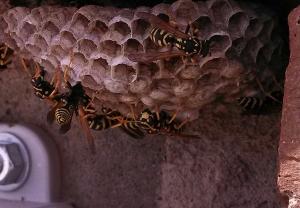There are 4 species of paper wasps that inhabit Colorado. As recently as the turn of the millennium, European paper wasps have taken up residence in Colorado and are frequently found within cities and around residences in the eastern and western portions of the state. They are less common in areas of higher elevation, but can still be found. The European paper wasp is commonly mistaken for a yellowjacket due to their vibrant yellow and black coloring. A narrower body and longer legs which seemingly dangle behind as the wasp flies are two of the distinguishing characteristics of the European paper wasp from a yellowjacket. Approximately 15-18 mm in length, adults are highly aggressive when threatened or protecting their nest. Due to this aggressiveness, stings are common when nests are accidentally encountered. This is the primary reason that these wasps cause concern among home and business owners. Paper wasp stings, like those from other stinging insects, can elicit potentially deadly allergic reactions.
Paper wasps in general are beneficial predators to caterpillars; however, the European variety is known to feed on multiple other insects, giving it an advantage over the native species within the state. Paper wasps do not scavenge or feed on trash type debris. Adults are seen through out the warmer months. Only the queen of the colony will overwinter and begin the process of starting the new nest and colony in the spring. Unlike native species, European paper wasps will not only build their nests under sheltered areas, they will also utilize small cavities for nest building. As their common name indicates, paper wasp nests have a paper-like appearance. They are umbrella shaped and cells are open in a downward direction. Cells that are closed off contain pupating young. A single queen in each colony is responsible for egg laying while secondary adults aide in formation and expansion of the nest, foraging and caring for the young.
Paper wasps do not attract to yellowjacket type wasp traps. While sealing gaps and crevices which may lead to small cavities will discourage nests in those locations, prevention of paper wasp nests is impractical. Due to the high probability of being stung, paper wasp extermination is best completed by a well equipped professional. Nests that become inactive in the fall and winter months can be removed and disposed of.
